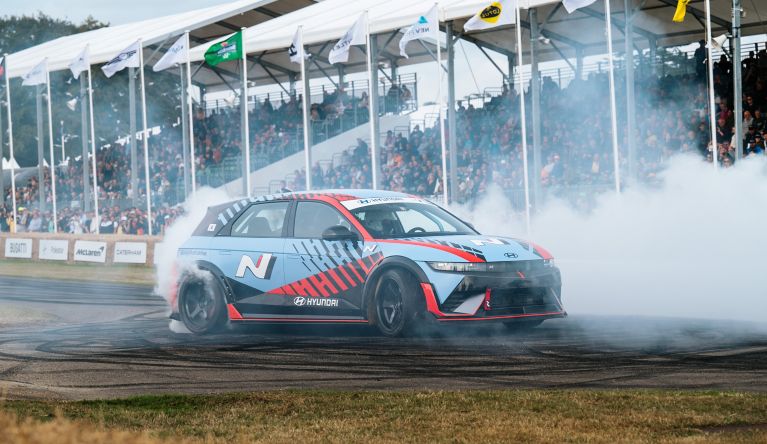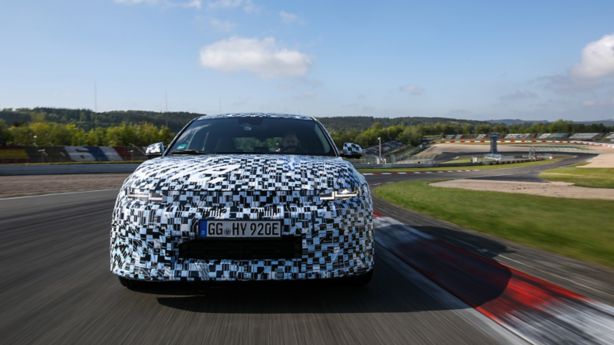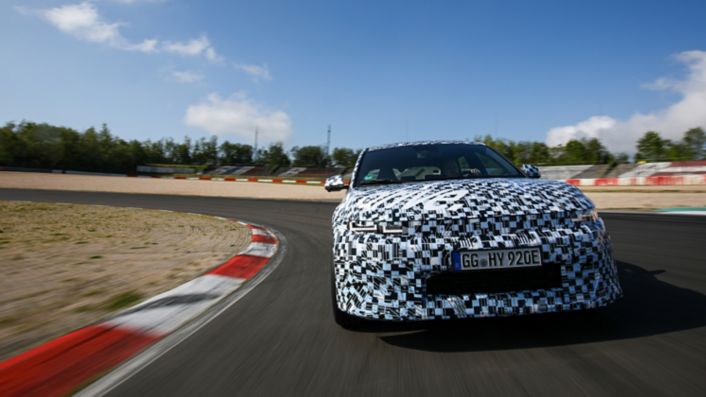In the buzzing halls of Hyundai Motor, a dream was taking shape – the dream of a car that would redefine the boundaries of all-electric high performance. This dream of electrifying Hyundai N was the brainchild of a core team, led by visionaries like Albert Biermann, Executive Technical Advisor for Hyundai Motor Group.
Biermann and the N brand team imagined a car that not only embraced the cutting edge of electric technology but also embodied the spirit of performance that defines Hyundai N’s model line-up. It was more than a project; it was a passion that powered the desire to create something extraordinary out of the realm of sustainable mobility.

As the dream gathered momentum, it became evident that making IONIQ 5 N a reality required more than just inspiration – it demanded an unprecedented level of international collaboration. This marked the inception of a project that brought together Hyundai teams from Europe, South Korea, and the U.S. Engineers, designers, and experts who had never collaborated with one another before found themselves united by a common goal. From the intricacies of sound design to the nuances of engineering for high-performance racetrack driving, this project blurred geographical boundaries, a fusion of skills and insights from every corner of the Hyundai ecosystem.

IONIQ 5 N | Development story
How to make an electric car deliver high performance
The story of IONIQ 5 N is not just about the final product but the journey it took to get there. What does it take to develop an electrified high-performance car that excels both on the road and racetrack? The answer lies in a meticulous blend of precision engineering, cutting-edge technology, and a commitment to performance. Hyundai’s automotive development focused on optimising key elements such as aerodynamics, suspension, and power delivery to ensure a seamless transition between everyday driving and high-performance track scenarios. Each step in this journey is crucial because every car, including IONIQ 5 N, possesses a unique character shaped by the dedication and expertise poured into its creation.
The key to development was guaranteeing that IONIQ 5 N truly belongs to the Hyundai N line-up. For this to happen, the Hyundai N engineers, or simply N-gineers, had to integrate the brand’s three core pillars into the process: Corner Rascal, Everyday Sportscar, and Racetrack Capability.



Electric cars aren’t too heavy for high performance
For IONIQ 5 N to be a Corner Rascal, Hyundai had to overcome the inherent high weight and size of electric cars. The answer? Enhancing rigidity through dedicated hardware, software, and control solutions to restore the necessary dynamics and make the car feel agile again. However, achieving greater rigidity presented a challenge, but the N-gineers identified structural and technological changes necessary to make it a reality.
Firstly, the structure of the IONIQ 5 base car was enhanced for greater rigidity. N-gineers achieved this by incorporating 42 additional welding points, increasing the adhesive length by 2.1 metres, and reinforcing the steering column to strengthen crucial body joints. These structural enhancements distinguish IONIQ 5 N from the IONIQ 5 base car as they are not typically found in high-performance variants of other electric cars in the industry.
The decision to do so yields tangible benefits for the driver. Designing IONIQ 5 N to be more rigid improves the limit handling performance and directness. The improved structure and dedicated local reinforcements minimise body torsions and deflections even more, allowing for better balance while accelerating, braking, and high-speed cornering. With more precision and predictability, drivers can maximise potential while sharply manoeuvring around corners.
The greatest challenge during development was revamping the control systems in IONIQ 5 N to improve its driving attributes, especially tuning them for all-wheel drive. The systems, including the Electronic Limited Slip Differential (e-LSD) and the Electronic Stability Control (ESC), among others, communicate with each other to enable the model’s cornering capabilities and torque vectoring. For example, ESC Normal can deliver racetrack fun, and ESC Sport provides the driver with even more agility and freedom behind the wheel.
IONIQ 5 N also introduces dedicated front and rear kinematics as well as a new suspension system to enhance feedback from the road. The updated Electronically Controlled Suspension (ECS) intelligently adapts the damping force to the current driving conditions. While driving on motorways, ECS provides softer settings for maximum comfort. However, the suspension stiffens up when it senses more demanding driving conditions.
Also tackling the challenges posed by IONIQ 5 N’s high weight are Integrated Drive Axles (IDA), Rack-Mounted Motor-Driven Power Steering (N R-MDPS), and specifically developed tyres. These systems collectively ensure optimal performance while cornering, preventing excessive understeer while securing a neutral handling balance.
With more rigidity from a reinforced structure, a new suspension, and other systems that provide superior handling and driving precision, the N-gineers succeeded in making IONIQ 5 N a true Corner Rascal.

Ready for the racetrack and the road
IONIQ 5 N not only embodies the spirit of high-performance driving, but it also upholds the Hyundai N pillar of Everyday Sportscar. For this, next to the technologies that enhance performance, the bright minds at Hyundai had to ensure that IONIQ 5 N offers practical features as well.
One aspect of achieving this balance between sportiness and practicality lies in IONIQ 5 N’s all-electric range. The high-performance model can reach 448 kilometres (under the WLTP testing standard), providing reassurance to car owners who may grapple with range anxiety – the fear that the battery will run out of power when driving an electric car, either before reaching the destination or a charging station.


Based on the Electric-Global Modular Platform (E-GMP), which is the same architecture used for IONIQ 5 and IONIQ 6, the N-gineers equipped IONIQ 5 N with similar charging capabilities. With the development of the N battery conditioning for fast charging times, the model can charge from ten to eighty per cent in a mere 18 minutes. This means less time spent at the charging station and more time enjoying the open road or racetrack.
In addition to ultra-fast charging, IONIQ 5 N was equipped with convenient Plug & Charge technology. This feature ensures a seamless and practical charging experience: Drivers can just plug in their car and charge without an app or charging card.
As the landscape of electric cars continues to change, IONIQ 5 N, as an electric sportscar, still stands as an outstanding choice for daily driving, offering reliability, convenience, and practicality.
Electric powertrains have a place on the racetrack
To help IONIQ 5 N live up to the Racetrack Capability pillar, the N-gineers had to make the IONIQ 5 faster, more powerful, and fiercer. As a first step, the same 84 kWh battery from base car was meticulously tuned to achieve top performance. However, unlike the base car distinguishes itself with high-performance motors in the front and rear that operate at an astounding 21,000 RPM. On top of this, the N-gineers applied a two-stage inverter with increased energy efficiency for stronger power output. With it, IONIQ 5 N delivers a staggering 650 PS with N Grin Boost activated, propelling the car from zero to 100 km/h in just 3.4 seconds and reaching a top speed of 260 km/h. With the highest power output among E-GMP-based models and the fastest top speed within the current Hyundai lineup, the IONIQ 5 N emerges as an impressive presence on both the road and the racetrack.
To manage the high weight of a fully equipped high-performance electric car, the N-gineers outfitted IONIQ 5 N with Hyundai’s most powerful braking system to date. The N-tuned braking system offers increased heat capacity, as well as features larger discs, lightweight metallurgy, and optimised airflow. The system includes N Brake Regen with a maximum decelerative force of 0.6 G. Drivers benefit from the system not only with optimal braking performance even under intense driving conditions but also with imperceptible transitions between N Brake Regen and the hydraulic brakes.
High-performance driving demands not only power but also resilience. To meet this need, an advanced battery thermal management system was developed. Equipped with an expanded cooling area, an improved motor oil cooler, and a battery chiller, the cooling system was engineered to optimise the battery’s potential. The model features two dedicated N Race modes: Endurance, which emphasises an immediate burst of full power and is ideal for hot laps, and Sprint, which prioritises track range for longer stints and is ideal for non-competitive track driving. With this achievement, Hyundai N-gineers have established a new standard for thermal management, particularly in handling demanding racetrack conditions.
This sophisticated system is not only resistant to heat-related power degradation, but it is also programmed to function efficiently. The N-gineers developed N Battery Preconditioning to ensure that the battery operates at an optimal temperature.
Putting IONIQ 5 N to the test
Hyundai voluntarily submitted IONIQ 5 N for testing in the German automotive magazine sport auto’s ‘Supertest’. Known for its extensive testing and reviews of high-performance sportscars, sport auto takes the selected vehicles to various racetracks and challenging roads to assess their capabilities in terms of acceleration, top speed, handling, braking, and overall dynamic performance.
This marked sport auto’s first-ever ‘Supertest’ with an electric car. Following IONIQ 5 N’s formidable run on the challenging Nürburgring-Nordschleife in Germany, the publication praised the model’s features, including rapid acceleration, precise torque vectoring, and an advanced cooling system – all elements that the N-gineers actively targeted during development. The ‘Supertest’ particularly highlighted the model’s responsiveness, handling, and agility despite its high weight, marking a step forward regarding the performance capabilities of electric cars.
Through IONIQ 5 N, Hyundai has succeeded in developing a high-performance car that overcomes the drawbacks of an all-electric powertrain. Achieving a lap time of 7:45.59 minutes, IONIQ 5 N established itself as the fastest mass-production Hyundai model to have ever been driven on the Nordschleife.
However, the N-gineers’ goals are not based on lap times; they aspire to develop cars that customers can enjoy on track days on any racetrack in the world. This was exactly their ambition when they completed a demanding feat on the Nürburgring – driving two full laps, recharging, and driving two additional laps. This challenge based on real-world conditions aligns perfectly with practical drive laps.
During the comprehensive development phase, IONIQ 5 N underwent thousands of kilometres of testing. Similar to other N models, IONIQ 5 N was driven for 10,000 kilometres on the Nürburgring. Additionally, the model was tested for 2,000 kilometres at the Korea International Circuit in Yeongam.
As the dust settles on the Nordschleife, IONIQ 5 N stands as a testament to Hyundai’s commitment to electrifying high performance. In the end, the dream that began in the buzzing halls of HMETC became a reality that echoes throughout the twists and turns of a racetrack. IONIQ 5 N rewrites the rules of what an electric car can do.
As the world increasingly embraces sustainable mobility, Hyundai has emerged as a leader, proving that dreams, passion, and international collaboration can transform the automotive landscape. The launch of IONIQ 5 N does not mark an ending; it is the beginning of a new chapter in the era of electrifying performance.
Disclaimer: CO2 and emissions data
- Fuel consumption combined for the Hyundai IONIQ 5 N in l/100 km: 0.0; CO2 emissions combined in g/km: 0.0 (WLTP)
















